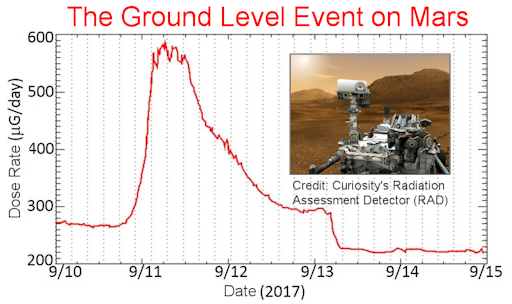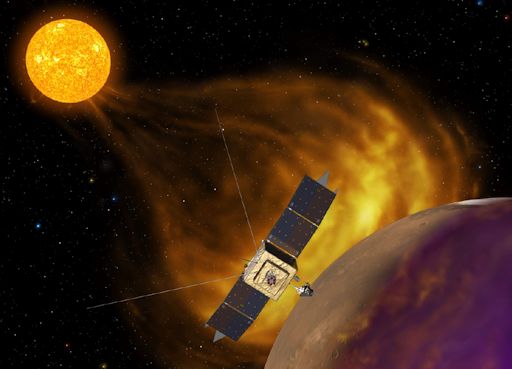More than 150 years after it happened, scientists are still taking about the Carrington Event—a solar storm in Sept. 1859 that sparked Northern Lights as far south as Cuba and sprayed the entire surface of Earth with high energy radiation.
On our planet, such global events are rare. On Mars, they happen surprisingly often—in fact, there was one just a few weeks ago.

The storm began on Sept. 10, 2017–a day the sun was supposed to be quiet: The solar cycle is currently at low ebb, near Solar Minimum, and strong flares are rare. Nevertheless, sunspot AR2673 erupted, producing a powerful X8-class solar flare that accelerated a potent spray of charged particles into space.
In a matter of hours, a “ground level event” (GLE) was underway on Mars. GLEs occur when energetic particles normally held at bay by a planet’s atmosphere or magnetic field penetrate all the way to the ground. Mars rover Curiosity detected the radiation spike as it crawled just south of the Martian equator.
“Radiation levels suddenly doubled and they remained high for nearly two days,” says Don Hassler of the Southwest Research Institute, principal investigator for Curiosity’s Radiation Assessment Detector (RAD). “This is the largest event we have seen since Curiosity landed in 2012.”

Earth was in the line of fire, too, but our planet’s magnetic field and thick atmosphere mitigated the effect of the storm. The terrestrial GLE on Sept. 10th was restricted to polar regions and amounted to a meager 6% increase–a tiny fraction of what happened on Mars.
Mars got walloped because, simply put, it is more vulnerable to space weather. The Red Planet has no global magnetic field to protect it, and an atmosphere only 1% as thick as Earth’s. Energetic particles from the Sept. 10th explosion peppered the entire dayside surface of Mars while auroras fringed the upper atmosphere all around the globe.
NASA’s MAVEN spacecraft saw the auroras using its ultraviolet imager. “If a human had been present, with eyes sensitive to visible light, they would have probably seen Mars lit up in green light (557.7nm) much like auroras on Earth,” says Sonal Jain of the Laboratory for Atmospheric and Space Physics (LASP) at the University of Colorado.
“Sonal had the excitement of being blown away when the raw data come in,” says his colleague Nick Schneider, also of LASP. “The auroras were 25 times brighter than the previous record.” Both scientists work with MAVEN data and specialize in Martian auroras.
“These global events are really interesting,” says Schneider. “On Earth It takes a truly extreme solar storm to cause global havoc thanks to the strength of our magnetic field. Mars’ lack of a global magnetic field means that planet-wide events are far more common. Indeed, since MAVEN went into Mars-orbit 3 years ago, we’ve seen a bunch of auroral displays that were probably global, even though this has been a really wimpy solar cycle.”
Hassler agrees. “Curiosity has seen 5 ground level events since 2012. They are not uncommon,” he says, “and they will probably grow stronger in the years ahead as we move through Solar Minimum and return to a more active phase of the solar cycle.”
Planners of future human missions to Mars will have to take into account the frequency of these “Martian Carrington Events,” increasingly revealed by rovers and orbiters of the Red Planet. Meanwhile, researchers are still poring over data from the latest, hoping to learn more. “Analysis of these observations, both at Mars and Earth, is just beginning,” says Hassler, “so stay tuned.”
Source: Spaceweather.com

































Leave a Comment
You must be logged in to post a comment.